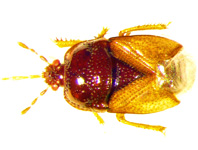Abstract
Paroctonchus nanjiensis gen. nov., sp. nov. is described from a sand beach in the China Nanji Islands Natural Reserve in the East China Sea. Paroctonchus nanjiensis is distinct in the family Oncholaimidae in having more than three teeth, a character found otherwise only in the monotypic genera Octonchus and Patagonema. The new genus and species differs from Octonchus and Patagonema in the number and pattern of teeth, bearing three large teeth with the left ventrosublateral one the largest plus about 27 small teeth distributed on the wall of buccal cavity. By contrast, Octonchus possesses one large tooth plus eight small teeth, while Patagonema has three large teeth with the right ventrosublateral one the largest plus 12 small teeth on three mandibular ridges. Moreover, Paroctonchus nanjiensis differs from Octonchus also in position of the amphidial aperture (located in the middle portion of buccal cavity vs. at the base of buccal cavity), and from Patagonema in the absence of a demanian system (vs. present) and the presence of two subventral rows of wart-like precloacal supplements (vs. a ventral row of papillate supplements). We provide an improved diagnosis for the subfamily Octonchinae, and discuss the evolution of teeth in the family Oncholaimidae.
References
Belogurov, O.I. & Belogurova, L.S. (1989) Morphology and systematics of free-living Oncholaimidae (Nematoda: Enoplida: Oncholaimina). Asian Marine Biology, 6, 31–58.
Belogurov, O.I. & Dashenko, O.I. (1981) Krampiinae, Oncholaimidae (Nematoda) with primitive features of organization (in Russian). Nauchnye doklady vysshei shkoly. Biologicheskie nauki, 1, 44–49.
Bik, H.M., Lambshead, P.J.D., Thomas, W.K. & Lunt, D.H. (2010) Moving towards a complete molecular framework of the Nematoda: a focus on the Enoplida and early-branching clades. BMC Evolutionary Biology, 10, 1–14.
http://dx.doi.org/10.1186/1471-2148-10-353
Clark, W.C. (1961) A revised classification of the Enoplida (Nematoda). New Zealand Journal of Science, 4, 123–150.
Coomans, A. (1979) Addendum I. A proposal for a more precise terminology of the body regions in the nematode. Annales de la Societé Royale Zoologique de Belgique, 108, 155–117.
De Coninck, L.A. (1965) Classe des Nématodes-Systématique des Nématodes et sous-classe des Adenophorea. In: Grassé, P. (Ed.), Traité de Zoologie. Masson, Paris, 4, 586–681.
De Ley, P. & Blaxter, M. (2002) Chapter 1. Systematic position and phylogeny. In: Lee D. (Ed.), The Biology of Nematodes. Harwood Academic Publishers, Reading, pp. 1–30.
de Man, J.G. (1907) Sur quelques espèces nouvelles ou peu connues de nématodes libres habitant les côtes de la Zélande. Mém Soc zool Fr, 20, 33–90.
Filipjev, I.N. (1916) Free living nematodes in the collection of the Zoological Museum of the Imperial Academy of Sciences in Petrograd. Ezhegodnik Zoologicheskago Muzeya Imperatorskoi Akademii Nauk, 21, 59–116. [in Russian]
Filipjev, I. (1918) Nématodes libres marins des environds de Sébastopol. Partie I (in Russian). Trudy Osoboi Zoologicheskoi Laboratorii l Sevastopol’skoi Biologicheski Stantsii, 4, 1–362.
Filipjev, I.N. (1929) Les nématodes libres de la baie de la Neva et de l'extrémeté orientale du Golfe de Finlande. Première partie. Archiv für Hydrobiologie, 20, 637–699.
Kreis, H.A. (1934) Oncholaiminae Filipjev, 1916. Eine monographische Studie. Capita Zoologica, 4 (5), 1–271.
Lorenzen, S. (1994) The phylogenetic systematics of free-living nematodes. Ray Society, London, 383 pp.
Meldal, B.H.M., Debenham, N.J., De Ley, P., Tandingan, De Ley, I., Vanfleteren, J.R., Vierstraete, A.R., Bert, W., Borgonie, G., Moens, T., Tyler, P., Austen, M.C., Blaxter, M., Rogers, A.D. & Lambshead, P.J.D. (2007) An improved molecular phylogeny of the Nematoda with special emphasis on marine taxa. Molecular Phylogentics and Evolution, 42, 622–636.
http://dx.doi.org/10.1016/j.ympev.2006.08.025
Murphy, D.G. (1966) An initial report on a collection of Chilean marine nematodes. Mitteilungen aus dem Hamburgischen Zoologischen Museum und Institut, 63, 29–50.
Pastor De Ward, C.T., Lo Russo, V. & Villares, G. (2015) Patagonema iubatum gen. nov. and sp. nov. (Nematoda, Oncholaimidae, Octonchinae) from Patagonia sandy beach (Argentina). Journal of the Marine Biological Association of the United Kingdom, 95, 101-109.
http://dx.doi.org/10.1017/S0025315414000708
Platt, H.M. & Warwick, R.M. (1983) Free-living Marine Nematodes. Part I: British Enoplids. Pictorial key to world genera and notes for the identification of British species. In: Kermack, D.M. & Barnes, R.S.K. (Eds.), Synopses of the British Fauna (New Series), no. 28. Cambridge University Press, Cambridge, pp. 169–171.
Schulz E. (1932) Beitrage zur Kenntnis mariner nematoden aus der KielerBucht. Zoologische Jahrbucher (Systematik) 62, 331–430.
Smol, N., Muthumbi, A. & Sharma, J. (2014) Order Enoplida. In: Schmidt-Rhaesa, A. (Ed.), Handbook of Zoology. Gastrotricha, Cycloneuralia, Gnathifera. Volume 2:Nematoda. De Gruyter, Germany, pp. 193–250.
http://dx.doi.org/10.1515/9783110274257.193
Somerfield, P.J. & Warwick, R.M. (2013) Meiofauna Techniques. In: Eleftheriou, A. (Eds.), Methods for the Study of Marine Benthos. Fourth Edition. John Wiley & Sons, Ltd, Oxford, pp. 253–284.
Van Megen, H., Van den Elsen, S., Holterman, M., Karssen, G., Mooyman, P., Bongers, T., Holovachov, O., Bakker, J. & Helder, J. (2009) A phylogenetic tree of nematodes based on about 1200 full-length small subunit ribosomal DNA sequences. Nematology, 11 (6), 927–950.
http://dx.doi.org/10.1163/156854109X456862

